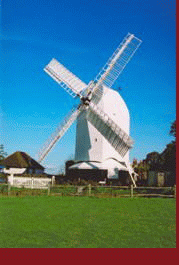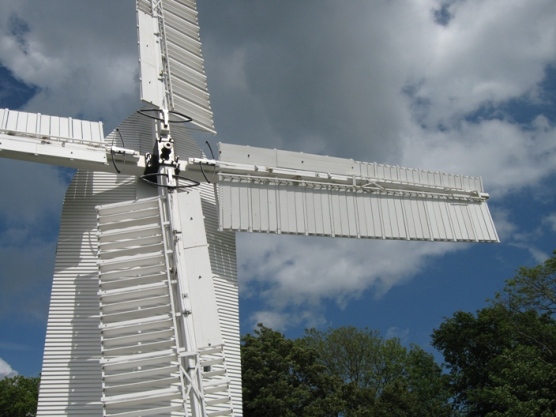






  |
 |
   |
 | ||
      |
   |
| www.oldlandwindmill.co.uk |
Diary Volume 5 November 2008 to January 2010 |
| Oldland Windmill is an 18th century post-mill situated in the village of Keymer in the County of West Sussex. She is currently being restored to full working order by a dedicated team of local volunteers. |
|
 |
|
2009 was another busy year with not much to see on the outside of the mill, except that we did fit and use the Windboards on the Sweeps. |  Windboards fitted and turning |
|
A continuous programme of work has been carried out refitting the inside of the mill with different teams working simultaneously on their own projects. The sackhoist was one major task. We had most of the original ironwork which Michael Peat refurbished and he also made a new wooden drum. Michael, Danny and Craig installed all this in the roof and I made a leather drive belt to take the power from the brakewheel to the sack hoist. This has yet to be tried under wind power, but all should work. |
|
| The sackhoist. The lever in the foreground moves the pulley upwards so that the leather belt is tensioned and takes drive from the brakewheel to the drum. |
|
| The small wooden toothed sackhoist drive wheel is raised so that the teeth engage with the brakewheel teeth and transmit drive via the belt to the sackhoist |
|
| Michael and Danny installing the sackhoist drum |
The flour dresser is another job that Michael is working on. There was very little left of the original woodwork but sufficient to use as patterns. Some of the metalwork was broken, but is now repaired. The dresser is a horizontal drum with metal gauze fastened to a wood frame. Meal (that which comes from the stones after wheat is ground, consisting of grains of flour in different sizes and the remains of the outer husk) is fed into one end of the flour dresser drum. The first half of which is covered with a fine metal gauze and the second half is covered with a slightly coarser gauze. Inside the drum are bristle brushes which rotate and push the meal against the gauze. Only the finest flour can pass through the first section and falls through a spout to the floor below (the spout floor). The next grade of flour is collected from the second half. Anything too coarse to pass through either gauze is collected from the end as Bran. |
|
|
The grain bin. The original design of the top floor of Oldland Mill (The bin floor) was that the flat floor was divided in two. The front section was to store grain for the front pair of stones and the rear for the other pair of stones. The grain was fed through a hole in the floor down a spout to the hopper. As we are not likely to use much grain at a time we decided to make a smaller bin with a sloping base so that the grain will flow easily to the hopper. The original design would have been fine with a lot of grain but would have required the use of shovels to empty the bin as the level of grain got near to the floor. |
|
|
|
Auxiliary drive. In the 1800s Oldland was modified so that a steam engine could drive all the mill machinery on windless days. A shaft came out of the side of the mill and this was belt driven by the steam engine. This is an ongoing project.( Does anyone have a steam engine that we can use ? ) |
|
| The auxiliary drive on the stone floor. The iron pulley wheel will be belt driven from a shaft on the floor below, the spout floor, which protrudes through the side of the mill with a pulley which is belt driven by a steam engine on the ground. |
|
Rear stones. (tail stones) The pair of stones at the back of the mill are French Burrs. Sections of a hard quartz stone set into plaster of Paris to form a millstone. All the machinery for the tail stones is being restored and put back into position. The tail wheel itself is completely rotten and will have to be rebuilt before we can use the tail stones. |
We had a hunt for a set of sack scales to weigh grain and sacks of flour. Ardingly Antiques Fair had some nice ones, I came across Michael Peat sitting on them but he had not noticed what they were as he was so busy looking for bells to add to his collection, however they were French. |
|
|
Roy Short came up trumps or rather Carol did. She remembered that her father, a smallholder, had some but they were passed on to her cousin, Arthur Kingsley, a farmer. Arthur still had them and kindly presented them to the Mill. Just what we needed and a nice family connection. |
|
Open Days. We had three open days during the year and we were very pleased to see so many visitors. We do not charge an entrance fee but everyone contributed generously and patronised the various stalls. Thank you so much as without your help we would not be able to keep Oldland Mill going and open to all. |
|
|
| Open Day 3rd May 2009. Dressed overall to celebrate approximately 100 years since she last ground corn. This photo also replicates the one which shows Oldland dressed overall to celebrate Queen Victoria's Golden Jubilee in 1887. |
|
| As you can see, we were busy. The queue to go into the mill. |
| The Morris men really pleased everyone. |
|
|
A weekend of celebration !
|  |
|
On the Saturday evening, we held a cheese and wine reception to thank all those neighbours, suppliers and sponsors who had helped to achieve the restoration to date. More than 70 guests attended the celebration held in twin marquees set up in the 'Llama Field' by kind permission of Fiona and Marcus Kemp. David Knight of Budgens generously provided all the food and drink at cost price, the sun shone (after a very wet week!) and even a light breeze developed in the evening so that the sweeps could be run under wind power.
|
|
At the end of 2008 we ground our first bucket of flour and in 2009 we have not done much more. We had a problem with the brakewheel not meshing smoothly with the quant. The brakewheel and the quant have both been re-aligned and the last run seemed fine so we hope we have cured the problem. The stones need to be run in a bit more to get rid of the grit and after that we hope to be able to supply you with some nice organic wholemeal flour in 2010. |
|
I started this website in about 2001, in a very primitive form, to record in words and photos the work of restoration. In 2002 Simon Potter used his expertise and rebuilt the website to its present sophisticated format. I joined the mill volunteers in 2000 when I retired from paid work and started ten years of unpaid hard labour. At that time the early volunteers who started in 1980 had fitted new supports to the original post, demolished the body of the mill, made and erected a new oak frame for the mill body. I have used the Diary to record our progress since then and now that we have completed the major work to the stage that we have ground flour I am putting away my quill and inkpot and signing off as the Diarist.
|
 |
 |
   Click here to visit Techpoint website |